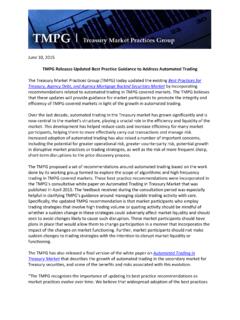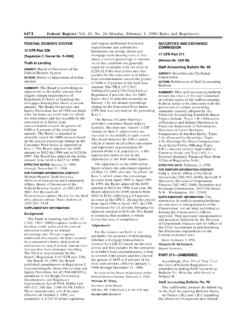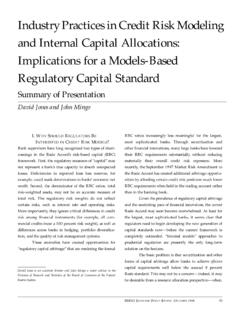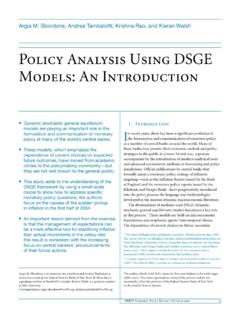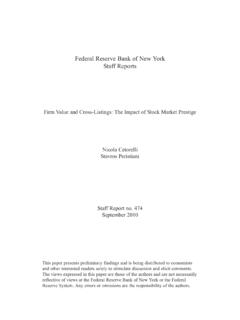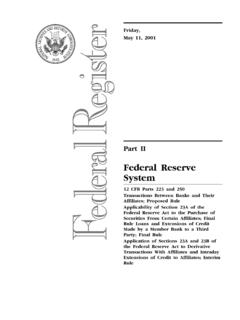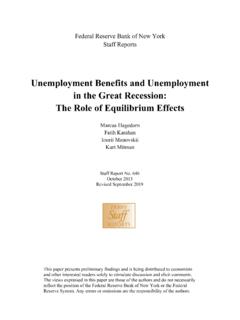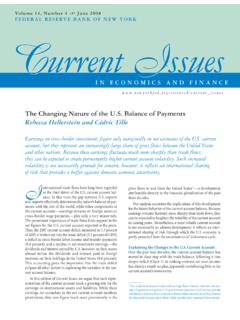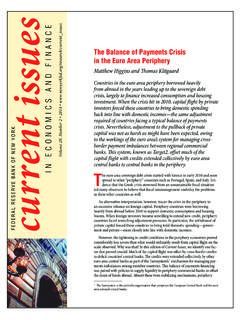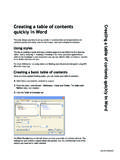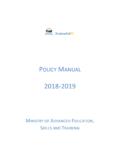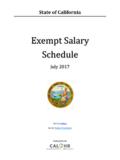Transcription of Table of Contents
1 ARRC RECOMMENDATIONS REGARDING MORE ROBUST fallback language FOR NEW ORIGINATIONS OF LIBOR S YNDICATED LOANS JUNE 30, 2020 Table of Contents Part I: Background about the ARRC and LIBOR fallback language .. 2 Part II: fallback language for New Originations of LIBOR Syndicated Loans .. 4 Part III: User s Guide to fallback language for Syndicated Loans ..10 A. Introduction to the fallback language ..11 2019 fallback language ..11 Interpretative Concepts of Interest Period, Available Tenor and Corresponding Tenor ..12 B. Triggers ..13 Permanent Cessation Triggers ..13 Pre-cessation Trigger - Benchmark is No Longer Representative ..14 Unavailability of Tenor of Benchmark ..15 "Early Opt-in ..16 C. Benchmark Replacement ..18 Waterfall ..18 Step 1: Term SOFR + Step 2: Daily Simple SOFR + Adju stment ..19 Modifications to the Waterfall.
2 22 Step 3: Borrower and Administrative Agent Selected Rate + Rate 23 Use of Screen 23 D. Benchmark Replacement Adjustment ..25 Step 1: ARRC Selected Adjustment ..25 Step 2: ISDA fallback Adjustment ..26 Step 3: Borrower and Administrative Agent Selected Adjustment ..27 Setting of the Benchmark Replacement 23 E. Conforming Changes ..28 F. Notices and Standards for Decisions and Determinations ..29 2 G. General Considerations ..29 H. Multicurrency . 30 Part I: Background about the ARRC and LIBOR fallback language The Board of Governors of the Federal Reserve System and the Federal Reserve Bank of New York convened the Alternative Reference Rates Committee ( ARRC ) in 2014 to identify alternative reference rates for dollar (USD) LIBOR ( LIBOR ), identify best practices recommendations for contract robustness in interest rate markets that currently use LIBOR, and create an implementation plan to support an orderly adoption of new reference rates.
3 After accomplishing its initial set of objectives by selecting a recommended alternative reference rate (which is the Secured Overnight Financing Rate or SOFR ) and setting out a Paced Transition Plan with respect to derivatives, the ARRC was reconstituted by the Board of Governors of the Federal Reserve System and the Federal Reserve Bank of New York in 2018 with an expanded membership to help ensure the successful implementation of the Paced Transition Plan and to serve as a forum to coordinate cash and derivatives markets as they address the risk that LIBOR may not exist beyond 2021. The ARRC now serves as a forum to address the impact of a possible LIBOR cessation on market participants currently using LIBOR and the development of SOFR based products across cash and derivatives markets. The ARRC s Second Report noted that most contracts referencing LIBOR do not appear to have envisioned a permanent or indefinite cessation of LIBOR and have fallbacks that would not be economically appropriate if this event occurred.
4 To meet its mandate to act as a forum for developing recommendations for voluntary transition, the ARRC formed a number of working groups to focus on various markets, including the Business Loans Working Group, and published its Guiding Principles for More Robust LIBOR fallback Contract language ( ARRC Guiding Principles )1 to create a framework for fallback language in cash products. Since September 2018, the ARRC has consulted on and recommended fallback language for floating-rate notes, syndicated and bilateral business loans, securitizations, and closed-end residential ARMs. These recommendations set forth robust fallback provisions that define the trigger events2, and allow for the selection of a benchmark replacement and a spread adjustment between LIBOR and that benchmark replacement to account for differences between these two benchmarks.
5 In the case of syndicated and bilateral business loans, the ARRC recommendations provided two approaches a hardwired approach and an amendment approach . The ARRC Guiding Principles3 state that fallback language efforts should evolve iteratively, recognizing that language may initially include higher degrees of flexibility or discretion in order to facilitate quicker incorporation of more robust fallback language where none currently exists, but fallback language should be expected to evolve to more specific language that leaves less ambiguity as to how fallback 1 ARRC Guiding Principles for More Robust LIBOR fallback Contract language in Cash Products published on July 9, 2018 at: https /2018/ARRC-principles-July20 18. 2 A tr i gger event i s a n oc curr enc e that pr ec ipitates the c onver sion fr om LI BOR to a new r efer ence r a te (i.)
6 E., a benchmark replacement). 3 Id. 3 rates and spread adjustments will be selected. In accordance with these Principles, and supported by responses to the 2018 consultation, the ARRC recommended fallback language for syndicated loans published in April 2019 ( 2019 fallback language ) included both an amendment approach and a hardwired approach. To date, the amendment approach has seen robust adoption in the broadly syndicated loan market, but syndicated loan facilities incorporating the hardwired approach generally have not been seen. The amendment approach uses loans flexibility to create a simpler, streamlined amendment process, but it may simply not be feasible to use the amendment approach if thousands of loans must be amended in a short period due to LIBOR cessation. Additionally, as described in the loan consultations, the amendment approach is likely to create winners and losers in different market cycles.
7 In a borrower-friendly market, a borrower may be able to extract value from the lenders by refusing to include a compensatory spread adjustment when transitioning to SOFR. Non-consenting lenders still would be subject to the lower rate. In a lender-friendly market, lenders might block a new proposed rate, forcing the borrower to pay a higher interest rate, such as ABR for a period of time. In light of these considerations, and the greater visibility that market participants now have with respect to how SOFR-based rates will be operationalized, the ARRC published recommended best practices in May 2020 which recommended the adoption of hardwired fallback language in business loans by the end of the third quarter of Hardwired fallback language offers certainty as to what the successor rate and adjustment will be and, in many cases, obviates the need for seeking consent for an amendment.
8 Market participants that adopt these fallback provisions can know that they will pay or receive a version of SOFR plus a spread adjustment upon a trigger event and parties will not be able to take advantage of the then-current market environment to capture economic value. Moreover, hardwired fallback language will likely be more executable on a large number of transactions at LIBOR transition. For these reasons, many respondents to the 2018 consultation who preferred the use of the amendment approach at that time generally believed that eventually some version of a hardwired approach would be more appropriate. The ARRC is now publishing refreshed recommended fallback language for market participants to consider for new originations of syndicated business loans referencing LIBOR. The refreshed recommendation provides for hardwired fallback provisions and does not provide a refreshed amendment approach.
9 To the extent market participants continue to enter into LIBOR-based contracts, the ARRC recommends and endorses the fallback language and related guidance herein and believes the cash markets will benefit by adopting a more consistent, transparent and resilient approach to contractual fallback arrangements for new LIBOR products. It is important to note that regardless of this recommendation, the extent to which any market participant decides to implement or adopt any suggested contract language is completely voluntary. Therefore, each market participant should make its own independent evaluation and decision about whether or to what extent any suggested contract language is adopted. Finally, while the ARRC s final recommendations include a forward-looking term rate as the primary potential successor rate, it is important to note that although such rate may be the optimal fallback for 4 ARRC Rec ommended Bes t Pra ctices for Completi ng the Tra nsition from LI BOR da ted Mar ch 2 7, 2 0 20 a t: https /arrc/files/2020/ARRC-Best-P ractic df.
10 4 products that were initially referencing LIBOR, the ARRC does not recommend that financial market participants wait until a forward-looking term SOFR exists to begin using SOFR in cash products. Part II: fallback language for New Originations of LIBOR Syndicated Loans The ARRC is recommending refreshed fallback language for new originations of LIBOR-referenced dollar-denominated syndicated business loans5 ( syndicated loans ). That language is set out in this Part II. The fallback language , as well as certain drafting alternatives and related guidance, is discussed in further detail in Part III: User s Guide to fallback language for Syndicated Loans. Benchmark Replacement Setting (a) Benchmark Replacement. Notwithstanding anything to the contrary herein or in any other Loan Document6 [(and any Swap Agreement shall be deemed not to be a Loan Document for purposes of this S ec tion titled Benchmark Replacement Setting )]7, if a Benchmark Transition Event or an Early Opt-in Election, as applicable, and its related Benchmark Replacement Date have occurred prior to the Reference Time in respect of any setting of the then-current Benchmark, then (x) if a Benchmark Replacement is determined in accordance with clause (1) or (2)
